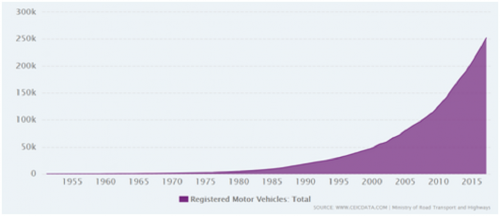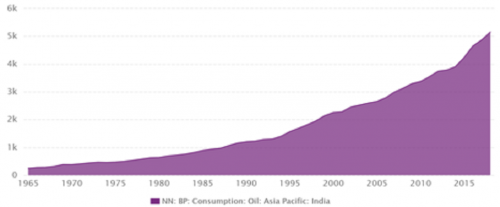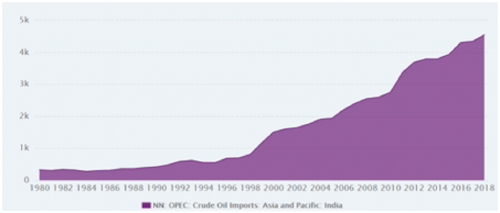Double dividend hypothesis claims environmental taxation can improve both environmental & economic conditions
Both economic development and the environment can be seen as rivals. It has been suggested by experts that developing countries need to take advantage of their natural resources and argue for significant economic growth through industrialization. This helps the economies move their population from subsistence level to substantial living.
History has proven that while industrial development and production drove Western economies to great economic growth in the past century, it also led to significant environmental degradation. The ‘London Smog’ in 19th century England, ‘Rivers on Fire’ in mid-20th century United States, the recent ‘Beijing Smog’ in China and the ongoing air pollution catastrophe in North India are prominent examples of trade-offs in developmental governance regimes.
It is no longer economic growth against environmental development. The citizens of both developed and developing nations demand a cleaner and safer environment, a new regime of governance known as ‘environmental governance’.
What is double dividend?
The possibility of earning a double income from environmental taxation instruments, or, rather, a bonus to achieve developmental goals from environmental conservation has been suggested by environmental economists.
David Pearce first presented the hypothesis in 1991. It claimed that environmental taxes, which are increasingly seen as an economic tool to encourage cleaner production and consumption, could improve economic and environmental conditions. This can be achieved through the imposition of an environmental tax and the recycling revenues that are used to reduce other taxes.
Freire-Gonzalez (2018) conducted a literature meta-analysis. This suggests that the double-dividend hypothesis is possible. However, there is not much empirical evidence to support the theory.
The recent changes in environmental-developmental perspectives and geopolitical situations provide “favourable” conventions for transitioning away from oil and building capacity and infrastructure for the adoption of new technology ecosystems like green energy and electric vehicles (EV).
India and other countries have the opportunity to realize the potential for a 2nd dividend and move towards cleaner technology. This article discusses the Double Dividend Hypothesis. It is based upon higher oil taxes, investment in EV vehicles push and its potential direct, indirect and spillover consequences.
Mobility ambitions, oil aversion
Because of their accessibility in areas that lack efficient public transport, the rising lifestyle standards, and the increased risk of infection transmission, passenger vehicles are increasingly preferred mode of transportation.
This is further bolstered by the banking sector’s capacity to provide affordable financing options for automobiles. India was the fifth-largest automotive market in the world in 2020.
Around 3.5 Million units of passenger and commercial vehicles were sold in India. Many companies started to explore India as an international export hub for their vehicles. Despite the fact these vehicles consume a lot oil and pollute the air during their lifetime, they are still very popular.
India: An exponential rise in the registration of vehicles

Oil consumption in India
India imports oil

India’s oil consumption was reported at 4,669.078 barrels per day in December 2020. This demand was more than 90% fulfilled by imports. This puts a heavy burden on India’s mobility ambitions.
India’s petrol prices have risen to Rs 100/litre, making mobility more difficult. A significant portion of petrol prices is due to heavy taxes levied centrally and by states.
In June 2020, tax component on petrol and diesel was 69 per cent and 58 per cent respectively. This means that more than half of the price paid by consumers is in taxes.
Excise (Union tax) on petrol increased by over 200 per cent to Rs 32.98 per litre in September 2020 from about Rs 10.38 per litre in March 2014. Excise duty from petroleum products contributes now 85-90% of all excise duty collected by the Union government, accounting for roughly 24 per cent of Indirect tax revenues in 2018-19.
Excise revenue of the Union government from petrol and diesel increased by over 94 per cent to Rs 3.34 lakh crore in 2019-2020 from Rs 1.7 lakh crore to about Rs 3.3 lakh crore in 2014-15. In the same period, the value added tax revenue for the state governments increased by 37 percent from Rs. 1.6 lakh crores to Rs. 2.2 lakh crore. The Observer Research Foundation compiled these data.

Circulating money for double dividend
During the 2021 hike in petrol prices, India’s oil minister Hardeep Singh Puri commented that levying such taxes helped the government fund social schemes, such as for providing free COVID-19 vaccines, meals and cooking gas to millions during the pandemic. These high taxes are an important part of welfare distribution.
India’s high taxes on petroleum products make it the ideal environment for hybrid and battery electric vehicles (BEVs) to be developed. Thus, this serves as the first dividend by cutting carbon emissions from the transportation sector.
India’s 2030 EV vision includes replacing 30 per cent private cars, 70 per cent commercial vehicles, 40 per cent buses and 80 per cent two-wheelers. This amounts to introducing 102 million units of EVs on India’s roads.
The second dividend of this hypothesis is financially strengthening the EV ecosystem by leveraging the income from petroleum taxes for adoption of “green industry”. Subsidies are already providing great support for the EV sector.
Phase II of fScheme for the adoption and manufacture of hybrid and electric carsA total of Rs 10,000 crore was allotted, while Rs 26,058 crore was given under the production linked incentives (PLI). The Rs 18,100 crore PLI is being used to provide production-linked benefits for advanced chemistry cells in India.
These developments are expected to lead to an estimated Rs 30,416 billion EV market in India by 2025. India received more than Rs. 25,000 crore of investment in the EV sector between January and June 2021. In the first quarter of 2021, India’s total foreign direct investment was around Rs 1,71,321 crore. According to the report, India will also see an investment of Rs 95.812 billion over the next five years. Electric Mobility in Full Gear 2021, India.
Apart from the capital gains, the EV industry will create around 10,000,000 jobs in India by 2030. These jobs include designing, testing, manufacturing and selling battery technology.
Ripple effects
New avenues could be opened by energy and mobility transition to greener technologies. One of these will be the rural agricultural industry, which is seeing an increasing demand for irrigation energy.
Despite the fact that almost 70% of India’s agriculture holdings lack adequate irrigation energy access and irrigation pumping energy requirements, 8-11% of India’s carbon emissions are still caused by this.
The transition to electric irrigation systems is inevitable. The capital-rich EV Innovation sector is leading efforts to develop high-efficiency brushless direct-current motors and other components.
The irrigation sector’s push for green energy, including the Pradhan Mantri Kisan Urja Suraksha evem Utthan Mahabhiyanscheme for solarisation, will facilitate large-scale transition to EV manufacturing sector. The sector will earn a significant dividend.
India’s current energy transition and high tax rates on polluting goods and services provide an apt situation to empirically observe the double dividend hypothesis change.
The outlook is promising, but it must be sustained in a global competitive market. India’s push for EVs is still nascent and its success is yet to be observed. To make a compelling case study of the double dividend hypothesis, it is necessary to analyze the current developments more thoroughly.
Views expressed are the authors’ own and don’t necessarily reflect those of Down to Earth
We are your voice; you have been our support. Together, we can build independent, credible, and fearless journalism. You can also help us by making donations. This will help us bring you news, perspectives, and analysis from the ground. Together we can make a difference.


